Executive Summary
The very essence of saving for retirement is to accumulate a nest egg sufficiently large enough to replace the retiree’s employment income and sustain a stable standard of living throughout retirement. If the prospective retiree doesn’t have enough saved up to maintain his/her lifestyle for the next several decades, it’s not yet time to retire.
Yet a growing volume of research studying the actual spending habits of retirees is revealing that this traditional approach may not be entirely appropriate after all. Because as it turns out, retirees don’t actually maintain a stable lifestyle in retirement; instead, spending levels tend to decline (in real terms), as the retiree goes from the “Go-Go” early years of retirement, to the “Slow-Go” years, and eventually the “No-Go” years.
In addition, not only does retirement spending slow in the later years, but the underlying composition of the retirement spending begins to shift as well as clients cross through these “age bands”, as spending on housing and entertainment activities fall significantly in the later years, while health care expenses are rising. Still, though, discretionary spending tends to fall by more than health care expenses rise – leading to an overall decrease in retiree spending as retirees proceed through the age bands.
Ultimately, this suggests that rather than merely assuming a stable standard of living throughout retirement, a better approach may be to look more directly at not just the composition of the retiree’s spending goals, but also how those particular types of expenses tend to change as the retiree moves through the different age bands. In other words, projecting retirement expenses using an age-banding approach may allow for a more nuanced and accurate representation of how spending will change over time. Which is important, because the data indicating that retiree expenses tend to fall throughout retirement – especially in some categories – implies that retirees may not actually need to be saving as much, or accumulating as large of a nest egg, to retire in the first place!
Age Banding To Understand How Retirement Spending Needs Change
The traditional view of retirement spending is that the person who can no longer work will aim to generate enough income to replace their earnings as a worker and maintain their existing standard of living. Of course, some aspects of that standard of living itself will no longer be necessary – from taxes paid on employment wages, to the savings that were being made to generate that retirement nest egg, and perhaps a handful of expenses (like commuting to work) that aren’t relevant anymore – and thus it may only be necessary to replace 70%-80% of pre-retirement income in retirement itself (the so-called “replacement ratio”). Nonetheless, whatever the actual expenses are that need to be supported in retirement, the assumption is simply that the goal is to support them at a continuing rate. Indefinitely.
Thus, the early approaches to securing retirement income were all various forms of pensions and lifetime annuities, which provided a fixed ongoing payment for life (made annually or perhaps monthly). With the inflation of the 1970s, though, combined with ever-increasing life expectancy, it became clear that the purchasing power of a fixed pension in retirement could be severely undermined over time, especially for retirees that might live decades in retirement. Thus, by the 1990s, the prevailing view – as embodied by Bill Bengen’s “4% rule” research – was that retirees should maintain retirement cash flows that weren’t just level, but adjust annually for inflation, which simply means sustaining a level real (inflation-adjusting) standard of living.
At the same time, a growing base of data on retirees in their later years began to reveal that the assumption of stable spending may not actually be an accurate reflection of reality. Instead, retirees appear to shift their spending behavior over time, in a manner that Michael Stein of “The Prosperous Retirement” first dubbed the three phases of retirement: the Go-Go years (the active first decade of retirement, largely a continuation of the pre-retirement lifestyle), the Slow-Go years (the less active second decade of retirement, as health and energy begin to decline, and some discretionary spending slows), and the No-Go years (the final decade of retirement, as most discretionary lifestyle spending stops altogether, supplanted with health care expenses instead).
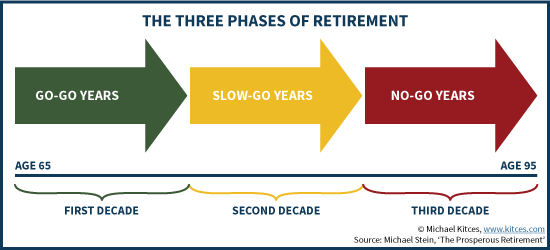
In essence, the idea is that spending behavior is retirement is not a consistent level amount (in nominal or real terms), but instead is distinct across several “age bands” in the first, second, and third decades of retirement. And during each of those bands, retirees shift in not only the level of their retirement spending, but also the composition. For instance, Somnath Basu suggested that spending in categories like basic living, leisure, health care, and taxes, may be substantively different (in different ways) across each age band.
[Tweet "Retirement spending patterns vary as retirees cross age-banding thresholds!"]
And as it turns out, subsequent research into the actual spending patterns amongst retirees across each age band is beginning to support the age banding hypothesis.
How Retirement Spending Declines As Retirees Age
For over 30 years, the Bureau of Labor Statistics has gathered information annually on household spending behavior through its Consumer Expenditure Survey (with select data available going back to the 1970s and early 1960s), providing a rich database to analyze consumer spending behaviors across different age cohorts and over time. And when researchers delve into the CES data, a clear trend emerges: retirement spending declines, persistently, over time.
For instance, a study in the Journal of Financial Planning by Ty Bernicke found that based on the 2002 CES data, for every 5 years older a retiree was, their spending was on average about 15% lower; the cumulative impact meant that those in their late 70s were spending less than half of what those in their late 50s were spending.
Notably, though, the Bernicke study looked at a cross-section of people in the same year to see the differences in spending by age, rather than actually track a cohort of people to see how their spending changed over time. When a subsequent study by the Center for Retirement Research looked at multiple age cohorts in the CES data, though, they still found that retirement spending drops persistently, by about 1% per year as a cohort ages, even after controlling for a number of other factors.
The challenge of cohort analysis, though, is that it still only looks at groups of people who were born in a similar grouping of years, and checks to see how the group as a whole changes its spending behavior over time. It doesn’t actually track the spending behavior of specific individuals and how they change over time.
A follow-up study by David Blanchett of Morningstar, though, used the Rand Health and Retirement Study (HRS), which actually does provide some longitudinal data on retiree spending behaviors over time. When Blanchett looked at the available data (which, admittedly, was somewhat limited by the sample size), a slightly different pattern emerged: real spending declined a little at the beginning of retirement, accelerated its decline in the middle retirement years, and then slowed its decline again in the final decade, in a pattern that was dubbed the “retirement spending smile”.
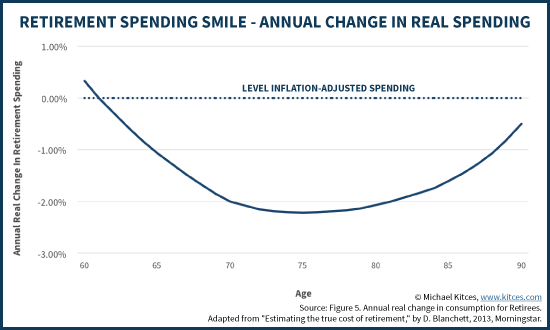
Notably, the chart above graphs the real (inflation-adjusted) change in spending, showing that real spending declines by an average of about 1%/year in the first decade of retirement, 2%/year in the second decade, and about 1%/year again in the final decade. Given that inflation itself averages more than 2%/year through most of the historical years in the data set, though, this still means that retirees were maintaining or slightly increasing their nominal spending each year. Just by less than the annual amount of inflation.
[Tweet "Real retirement spending tends to decrease by at least 1%/year throughout retirement!"]
Differences In Spending Patterns By Retirement Age Band
A key aspect of the Blanchett retirement spending smile is that while real spending declines in retirement, at a rate that is slower, then a bit faster, then a bit slower again, it’s not just that the absolute level of (real) spending is changing. The spending pattern itself is largely a reflection in shifts in what retirees are spending on, as they age.
For instance, using the CES data, Blanchett looked at the composition of spending throughout an individual’s lifecycle (from age 25 to 85), and found that in the retirement years, there are distinct shifts in the composition of retirement spending. As retirees age, some spending categories steadily decline – e.g., insurance premiums (as life insurance, disability insurance, and eventually automobile insurance become less necessary), transportation (as the household consolidates to 1 or even 0 cars), housing (as spending on new furniture and other household goods slows down), and clothing – while other categories rise (most notably, health care).
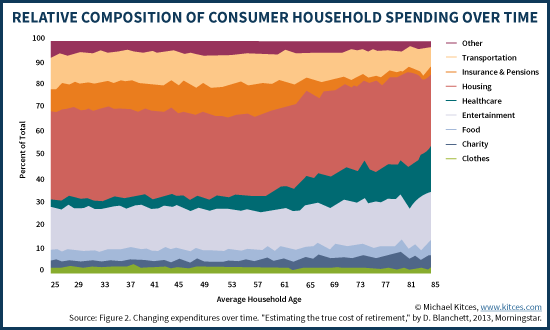
A similar study by JP Morgan, which analyzed spending patterns based on JP Morgan’s own proprietary data of how its clients spend (using consumer credit and debit card data), and focusing on more affluent households (those with $1M to $2M of investible assets), similarly found a version of the retirement spending smile, albeit more lopsided – where real spending clearly decreases in the early retirement years, but appears to merely level off in the later years (as health care spending in particular ramps up for those in their 80s). Still, though, retirement spending was down by about 1%/year through the first 20 years of retirement.
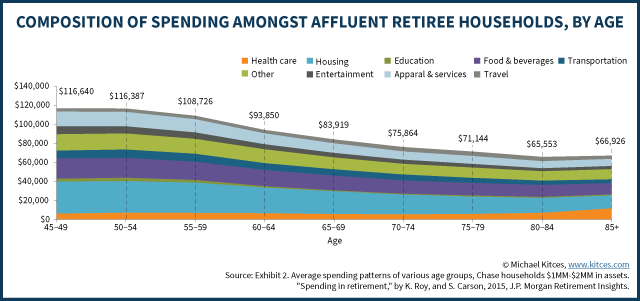
One notable aspect of these results is that while health care expenses do ramp up in the later years, health care expenditures overall are still only a relatively moderate percentage of the retiree’s total spending, falling roughly in the 15% - 20% range, and not even fully replacing the decreases in spending in the other categories (such that total spending in a retiree’s 80s is still more than 20% below where it was at the beginning of retirement). In other words, health care expenses really do rise in the later years of retirement, but not enough to raise total spending in the later years of retirement!
To a large extent, this speaks to the relative effectiveness of Medicare in holding a household’s health care expenditures relatively stable in retirement; while it may cost upwards of $5,000/year for an individual (or $10,000/year for a couple) to maintain Medicare Part B premiums, plus Part D, and a Medigap Supplemental policy, from that point forward the bulk of the expenses are relatively modest co-pays, such that health care spending rises only moderately in the final years. And in fact, since the data on health care would include all such expenditures – both for medical needs, and also for long-term care expenses – in reality the spending for medical-related health care expenses appears to be even more stable, as a material portion of the later years’ increase is likely attributable to a small subset of consumers with larger (uninsured) long-term care expenses.
Implementing An Age-Banding Approach For Retirement Spending
So how might the research on age-banding retirement spending be incorporated into financial planning projections for clients?
The first option would simply be to reflect the tendency for retirees to spend less as they age and move through the Go-Go, Slow-Go, and No-Go years. For instance, spending could be projected to decrease by 10% each decade in retirement (i.e., cutting spending by 10% at age 70, another 10% at age 80, and yet another 10% at age 90). The middle decade could be cut by even more – such as 15% or even 20% - to reflect Blanchett’s “retirement spending smile” (that spending decreases even faster in the middle Slow-Go decade).
Notably, though, while the research suggests these spending decreases as people move across age bands, for any particular individual, the shift is more likely to be driven by a health-related event (e.g., Mom falls and breaks her hip, and from that point forward doesn’t want to travel or eat out as much) rather than reaching an arbitrary age threshold. Thus, in real life a spending cut might happen to occur “promptly” as someone moves across an age band, but it may well be off by several years as well. Thus, an alternative approach might also just be to project retirement spending to increase by 1% less than the expected rate of inflation (e.g., 1% less than the inflation rate being used to inflate other fixed income streams), such that real spending decreases by 1%/year. This will still reflect the cumulatively likelihood of anticipated spending changes, without making the plan unusually dependent on a big change in a particular future year that might not actually occur at that exact time.
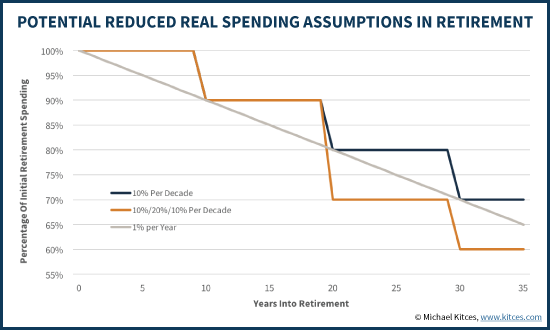
Of course, as noted earlier, the reality is that the decreases in retirement spending over time are less a function of absolute reductions in spending across the board, and more a result of significant spending decreases in some categories (mostly related to leisure and discretionary spending), with less-than-full substitutes in other categories (such as health care and medical expenses).
Thus, a better implementation of Basu’s age-banding approach might break expenses into more concrete categories, such as his suggested “Basic Living” (essentials), “Leisure” (discretionary), “Health Care”, and “Taxes”. This makes it feasible to not only adjust different categories of spending at different rates as the retiree ages, but also to reflect the different inflation rates that apply to each (especially given how health care expenses inflate higher than other expenses). For instance, spending on essentials might be projected to decline at 10% per decade (in real dollars), but leisure could fall by 20% per decade, and healthcare might be projected to rise by 10% per decade. In addition, healthcare could be projected with a higher inflation rate than the other categories.
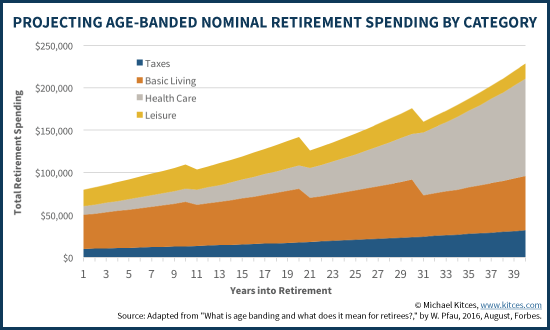
In turn, both the starting levels of the retiree’s budget, and the projected adjustment factors, could then be specified to the individual situation. For instance, the JP Morgan study found that almost 40% of retirees are “foodies” who spend disproportionately on food and beverages, while about 30% are “homebodies” who tend to spend more on housing-related goods, and about 5% are “globetrotters” who engage in a high volume of travel. Accordingly, globetrotters might have their own “travel” category, that starts out much higher (as a percentage of spending), but falls off the most in their 80s (when they presumably wouldn’t travel much anymore), while the “homebodies” might have a larger allocation to basic living expenses that inflate more slowly but decline very little. Though notably, retirees may not be very good at projecting their own lifestyle changes in the later years of retirement – a version of the so-called “End Of History Illusion” – and thus may need guidance from the advisor about what kinds of spending cuts (or not) to project in various categories in the later years.
[Tweet "The End of History Illusion makes it difficult to projecting spending changes in later retirement!"]
In practice, doing this kind of projected retirement spending may also be more difficult in today’s financial planning software, simply because most of the tools aren’t built to handle multiple different spending categories, each with their own inflation rates and age-banded spending cuts. Though in theory, entering each spending category as its own “goal” may be feasible in most goals-based planning software platforms to at least get close (but it still may not be possible to project varying inflation rates over time?), and cash-flow-based financial planning software tends to be granular enough to allow the individual cash flows to be projected (though it may be time-intensive to program them).
Nonetheless, the fundamental point is that while it varies by research study what the exact magnitudes of spending declines are in various categories, and the age-banded thresholds when they apply, the data from both the BLS’ Consumer Expenditure Survey and the RAND Health and Retirement Study (HRS) both support the idea that retiree spending does not remain stable throughout retirement. It clearly declines, at least to some extent, which can impact everything from how much is “safe” to spend at the beginning of retirement (before these subsequent adjustments apply), to how much the prospective retiree needs to retire, and how much he/she must save as an accumulator to get there. Which means projecting some decrease in retirement spending in later years – any ‘reasonable’ decrease – is arguably a better baseline for retirement planning than the current default of assuming no decreases at all!
So what do you think? Do you assume that retiree spending will decrease in the later retirement years? By how much? Please share your thoughts in the comments below!





I’ve recognized this phenomenon for several years and it is now confirmed with good research. It is also worth noting that the percentage of earnings to be “made up” in retirement is much lower for the high income person than for the low income. What I’ve struggled with is the notion of how much reduction and when. It certainly isn’t the smooth downwards curve depicted in one chart. What I generally do is first plot the results without any adjustment. If the assets remain in play for the full life then no problem, but I advise the client of the reality and that the reduced spending is likely, thereby making the plan even more likely to succeed. If the client’s resources are tight, I generally build in a 5% reduction at arbitrary points, usually about like the decade bands described. I don’t like to go lower because there are too many undefined influencers and I’d prefer to not paint an overly optimistic picture. I certainly agree that healthcare costs are relatively predictable and not catastrophic if decent health insurance is obtained. I am always a bit bemused by the articles that tell one about the enormous cost of healthcare in retirement, but never mention the cost of food or rent. I’ve never heard of anyone having a healthcare investment portfolio, but an HCA during working years may help. I could push my estimate to drop at ten year intervals by 10% and that is easily justified. I just prefer to err on the conservative side.
Indeed, in our firm I find that the spending declines tend to be ‘lumpy’. Retirees live the 60-something lifestyle, until someone has a fall and breaks a hip, and after that it aches and they don’t like to travel so much and the travel budget drops precipitously. Then someone’s eyesight deteriorates a bit too much, and they decide it’s no longer a good idea to drive at night, and suddenly the restaurant budget falls off a cliff.
I’ll admit that reality is why I tend to lean a bit towards “chunky” spending declines projected conservatively (e.g., by 10% in 10 years, another 20% in 20 years, etc.), as opposed to just projecting a real spending decline of 1%/year. Averaged across the population, the decreases are that smooth because a random percentage of retirees every year have a health event. But for any particular retiree, it doesn’t seem to be nearly as smooth of a decline…
– Michael
We are in synch, Michael. Great article. One must deal with the realities of clients, not some theory.
Michael – thanks for broaching this topic. Current Monte Carlo models assume constant spending along with inflation! The fact is ( and as a healthy and active and traveling retiree I can attest to it) your spending goes down. Plus with 90 year old inlaws and a father who lived to 85 I can tell you those later years spending declines dramatically. In addition, inflation does not equally impact all age brackets the same. Even if you still have a mortgage it is “fixed”. Many states lock property tax for seniors and old folks just don’t partake much in what are truly the inflationary items. Medical care goes up but Medicare does a great job. The flip side of all this of course is that the “heirs” will be a whole lot happier ! Well done web site and insights. The industry is lucky to have you.
Temporary comment: The orange line/caption in your Potential Reduced Real Spending graph don’t seem to quite match up. The orange line starts at 100, drops to 80, then to 70-ish percent (so 20% reduction, then 10% reduction); the caption says reduction of 10%/20%/10% per decade.
Great post! Thanks so much.
Great stuff Michael! It would be very interesting and quite powerful to see a bar chart comparing total spending in a traditional retirement financial plan, e.g. 2-3% inflation on living expenses, 5-7% for health care, versus one using this methodology.
Also, I think a good start for financial planning software would be to simply allow for a different inflation rate for pre-retirement and post-retirement. Of course, medical expenses are treated separately.
Another factor that supports this data (although difficult to quantify) is that retirees are some of the best shoppers in the world. They have time to sift through the coupons, go to different stores to get the best deal, hit the early-bird specials, and wait for something to go on sale.
Another great article and one which increases my already high level of confidence that our money will last throughout our retirement planning horizon.
One thing I don’t quite get is why retirement spending declines during the first 10 years of retirement (the retirement spending smile chart showing the decline happening in year of two of retirement). It would seem to me that if you set the initial year at what you are actually going to spend and in fact spend that amount, why would it decline in the next year and the 8 others that follow if these are to be the “go-go” years?
I get the declines happening in the second and third decades of retirement, but it’s the first decade that seems puzzling to me.
Thanks Michael,
Mike
I think because you don’t drive to work everyday.
Thanks Michael – great summary. I appreciate your thoughtful articles.
I think the elephant in the room that these spend less gurus are ignoring is the cost of long-term care during the last few years in life. This will result in a MAJOR INCREASE IN SPENDING later in life to the tune of $70-80,000 / year for possibly several years. How do the spend less gurus account for this major spike in retirement spending later in life?
Very interesting. In our practice we’ve moved to a baseline(floor) of income raising modestly @1%, with individual lifestyle goals that don’t last the entire retirement. I’ll have to model our current approach along with a decrease as you mentioned.
Thanks for the great work you do.